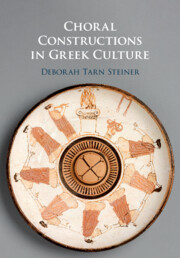 Choral Constructions in Greek Culture
Choral Constructions in Greek Culture Book contents
- Choral Constructions in Greek Culture
- Choral Constructions in Greek Culture
- Copyright page
- Dedication
- Contents
- Illustrations
- Preface and Acknowledgements
- Introduction
- 1 Choreia at the Forge: Tripod Cauldrons, Golden Maidens and the Choral Dancers on Achilles’ Shield in Iliad 18
- 2 From the Demonic to the Divine: Gorgons, Cauldrons and Choral Dance
- 3 Flying with the Birds: Avian Choreia and Bird Choruses in Art and Text
- 4 The Carnival of the Animals: Dancing in Herds
- 5 Water Music: Nymphs, Ships and Choral Aquatics
- 6 A Chorus of Columns: Pindar’s Agalmata and the Architectural Chorus
- 7 Choral Fabrications: Weaving, Cloth-Making and Choral Song and Dance
- 8 Choreo-graphy: Choreia and Alphabetic Writing
- 9 Girls in Lines: Catalogues and Choruses
- 10 Choral Envisioning: Archaic and Early Classical Choral Lyric and Post-Classical Accounts of Enargeia
- Bibliography
- Index Locorum
- Subject Index
4 - The Carnival of the Animals: Dancing in Herds
Published online by Cambridge University Press: 20 May 2021
- Choral Constructions in Greek Culture
- Choral Constructions in Greek Culture
- Copyright page
- Dedication
- Contents
- Illustrations
- Preface and Acknowledgements
- Introduction
- 1 Choreia at the Forge: Tripod Cauldrons, Golden Maidens and the Choral Dancers on Achilles’ Shield in Iliad 18
- 2 From the Demonic to the Divine: Gorgons, Cauldrons and Choral Dance
- 3 Flying with the Birds: Avian Choreia and Bird Choruses in Art and Text
- 4 The Carnival of the Animals: Dancing in Herds
- 5 Water Music: Nymphs, Ships and Choral Aquatics
- 6 A Chorus of Columns: Pindar’s Agalmata and the Architectural Chorus
- 7 Choral Fabrications: Weaving, Cloth-Making and Choral Song and Dance
- 8 Choreo-graphy: Choreia and Alphabetic Writing
- 9 Girls in Lines: Catalogues and Choruses
- 10 Choral Envisioning: Archaic and Early Classical Choral Lyric and Post-Classical Accounts of Enargeia
- Bibliography
- Index Locorum
- Subject Index
Summary
A fragment of Pindar preserved and identified by Athenaeus as a hyporcheme (14.631c = fr. 112 S.-M.) describes a Spartan parthenaic troupe (if the text is sound) as an ἀγέλα or ‘herd’. The term recurs in a second Pindaric composition, fr. 122 S.-M., where it again refers to a troupe of maidens, these expressly figured as cows, who take part in a choral-style performance en route to a sacrifice. In a third usage of the expression in fr. 70b.22 S.-M., the Pindaric performers of this dithyramb apply it to the herd of wild beasts, their species undefined, whose collective dancing in a cacophonous chorus made up of gods, nymphs, animals and other sonorous objects is said to ‘enchant’ Dionysus (ὁ δὲ κηλεῖται χορευοίσαισι κα[ὶ θηρῶν ἀγέλαις); in this instance the scene imagined by the singers stands as the template and paradigm for their own more earth-bound choreia, similarly staged by way of tribute to the god as they participate in his signature choral genre.
- Type
- Chapter
- Information
- Choral Constructions in Greek CultureThe Idea of the Chorus in the Poetry, Art and Social Practices of the Archaic and Early Classical Period, pp. 182 - 257Publisher: Cambridge University PressPrint publication year: 2021
